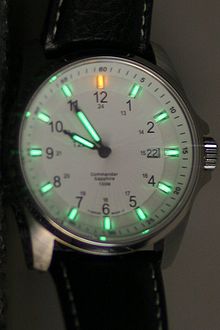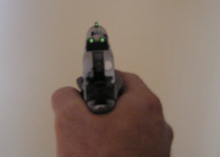Tritium radioluminescence: Difference between revisions
m →Health concerns: corrected word misuse -- substitued "introduction" for "constitution" |
m Tritium does not "regularly" emit electrons. It does "randomly" emit electrons, but that would complicate the introduction. So remove "regularly" |
||
| Line 1: | Line 1: | ||
[[Image:Trtium.jpg|thumb|right|300px|[[Radioluminescent]] 1.2 Curie 4" x .2" Tritium vials are simply tritium gas filled thin glass vials whose inner surface are coated with a [[phosphor]]. The "gaseous tritium light source" vial shown here is 1.5 years old.]] |
[[Image:Trtium.jpg|thumb|right|300px|[[Radioluminescent]] 1.2 Curie 4" x .2" Tritium vials are simply tritium gas filled thin glass vials whose inner surface are coated with a [[phosphor]]. The "gaseous tritium light source" vial shown here is 1.5 years old.]] |
||
'''Tritium illumination''' is the use of gaseous [[tritium]], a radioactive [[isotope]] of [[hydrogen]], to create visible light. Tritium |
'''Tritium illumination''' is the use of gaseous [[tritium]], a radioactive [[isotope]] of [[hydrogen]], to create visible light. Tritium emits [[electron]]s through [[beta decay]], and when they interact with a phosphor material, [[fluoresce|fluorescent light]] is created, a process called [[radioluminescence]]. As tritium illumination requires no electrical energy, it found wide use in applications such as emergency [[exit sign]]s and illumination of wristwatches. More recently, many applications using [[radioactive]] materials have been replaced with [[photoluminescent]] materials. |
||
== Tritium lighting == |
== Tritium lighting == |
||
Revision as of 22:01, 15 March 2010
Tritium illumination is the use of gaseous tritium, a radioactive isotope of hydrogen, to create visible light. Tritium emits electrons through beta decay, and when they interact with a phosphor material, fluorescent light is created, a process called radioluminescence. As tritium illumination requires no electrical energy, it found wide use in applications such as emergency exit signs and illumination of wristwatches. More recently, many applications using radioactive materials have been replaced with photoluminescent materials.
Tritium lighting

Tritium lighting is made using glass tubes with a phosphor layer in them and tritium (a hydrogen isotope) gas inside the tube. Such a tube is known as a "gaseous tritium light source" (GTLS), or beta light, (since the tritium undergoes beta decay).
Self-luminous microspheres
A patent application was filed by the US Patent Office in 2007 for sand-grain-sized tritium containers or glass or polymer "microspheres" that can be applied in self-powered lighting paint.[1]
The patent application states that the plurality of individual containment microspheres minimizes the escape of radioactive gas in the event of any physical damage to an assembly of such microspheres. It also states that the radioactive gas has a relatively large contact surface with the phosphor particles, thus causing a relatively efficient light emission from the surface of the particles.[2][3] No actual paint is known to have been produced yet.
Physics
The tritium in a gaseous tritium light source undergoes beta decay, releasing electrons which cause the phosphor layer to fluoresce.
During manufacture, a length of borosilicate glass tube which has had the inside surface coated with a phosphor-containing material is filled with the radioactive tritium. The tube is then fused with a CO2 laser at the desired length. Borosilicate is preferred because it is a type of glass noted for its strength and resistance to breakage. In the tube, the tritium gives off a steady stream of electrons due to beta decay. These particles excite the phosphor, causing it to emit a low, steady glow. One could use any beta particle-emitting substance, but in practice tritium is preferred because it is not very hazardous.
Various preparations of the phosphor compound can be used to produce different colors of light. Some of the colors that have been manufactured in addition to the common phosphorus green are red, blue, yellow, purple, orange, and white.
The types of GTLS used in watches give off a small amount of light—not enough to be seen in daylight, but enough to be visible in the dark from a distance of several meters[citation needed]. The average such GTLS has a useful life of 10–20 years. As the tritium component of the lighting is often more expensive than the rest of the watch itself, manufacturers try to use as little as possible. Being an unstable isotope with a half-life of about 12.36 years, tritium loses half its brightness in that period. The more tritium that is initially placed in the tube, the brighter it is to begin with, and the longer its useful life. Tritium exit signs usually come in three brightness levels guaranteed for 10, 15, or 20 year useful life expectancies[citation needed]. The difference between the signs is how much tritium the manufacturer installs.
Uses of tritium illumination

These light sources are most often seen as "permanent" illumination for the hands of wristwatches intended for diving, nighttime, or tactical use. They are additionally used in glowing novelty keychains and in self-illuminated exit signs. They are also favored by the military for critical applications where illumination of the glow-in-the-dark sort is desired but a power source may not be available. Some uses of this sort are analog dials in aircraft, in compasses, and sights for weapons.
Tritium lights are also found in many old rotary dial telephones, though due to their age they no longer produce any useful amount of light.
Tritium lights or beta lights were formerly used in fishing lures.
Small arms sights
|
Legal issues
Because tritium in particular is an integral part of thermonuclear devices (though in quantities several thousand times larger than that in a keychain), consumer and safety devices containing tritium for use in the United States are subject to certain possession, resale, disposal, and use restrictions. Devices such as self-luminous exit signs, gauges, wrist watches, etc., which contain small amounts of tritium are under the jurisdiction of the U.S. Nuclear Regulatory Commission, and are subject to possession, distribution, import and export regulations found in 10 CFR Parts, 30, 32 and 110. They are also subject to regulations for possession, use and disposal in certain states. They are readily sold and used in the US and are widely available in the U.K. Some countries, Belgium for example, have outlawed them.[4] Tritium lighting is legal in most of Asia and Australia.
Health concerns
While these devices contain a radioactive substance, it is currently believed that self-powered lighting does not pose a significant health concern. However, a 2007 report by the UK government's Health Protection Agency Advisory Group on Ionizing Radiation declared the health risks of Tritium exposure to be double that previously set by Sweden's International Commission on Radiological Protection.[5]
Tritium presents no external radiation threat when encapsulated in non-hydrogen-permeable containers; its only danger is its introduction into the human body from direct contact, which may in turn cause long-term, low-dose radiation damage. This is because beta decay radiation from tritium is not very energetic; it is incapable of penetrating through glass containers or even intact human skin.[6]
Direct, short-term exposure to small amounts of Tritium is relatively harmless. If a tritium tube should break, one should leave the area and allow the gas to diffuse into the air. Tritium exists naturally in the environment, but in very small quantities.
References
- ^ http://www.freepatentsonline.com/y2007/0200074.html Long life self-luminous microspheres
- ^ http://www.rexresearch.com/kohnen/kohnen.htm Long life self-luminous microspheres / Litrosphere paint
- ^ http://www.createthefuturecontest.com/pages/view/entriesdetail.html?entryID=567 Litroenergy - New Light Source Material
- ^ Verboden gadgets (link dead; no longer applicable?) (Dutch)
- ^ "Healt Protection Agency Advisory Group on Ionizing Radiation". press release on Tritium health risk. Retrieved 2007-12-02.
- ^ "www.ehso.emory.edu" (PDF). Nuclide Safety Data Sheet Hydrogen-3. Retrieved 2006-11-09.
External links
- Cleanup of a broken tritium sign
- Radioluminescent items
- Forum discussion on Superluminova vs. Tritium
